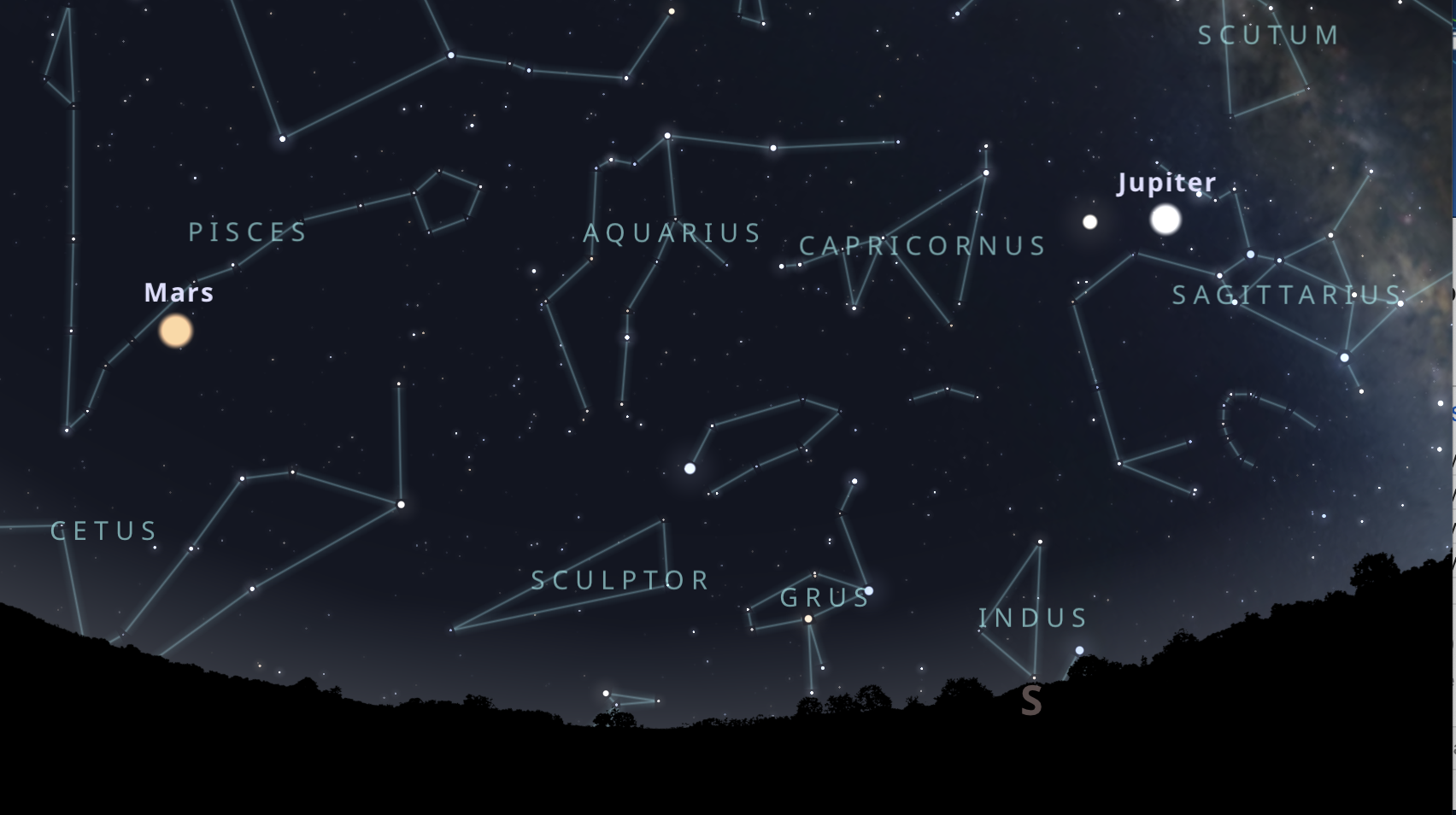

The constellations visible in the south during the Northern Hemisphere autumn months (overhead on spring evenings for the Southern Hemisphere) constitute a celestial sea. In 2020, the planets Mars, Jupiter and Saturn are bright in this region of the sky. Chart via Stellarium.
Tonight, come to know what Northern Hemisphere stargazers call the ocean in the autumn sky. It’s an ocean overhead in the spring sky for Southern Hemisphere stargazers. The equinox marking autumn and spring took place on September 22 at 13:31 UTC. And so we’re now well into these seasons, both on the Earth below and in the sky. The chart at the top of this post – looking from a Northern Hemisphere location, southeast to south on a late October or early November evening – makes this part of the sky look crowded. But, if you look, you’ll find only one bright star shining here, plus, in 2020, the three bright planets Mars, Saturn and Jupiter.
Note for Southern Hemisphere stargazers: You can see this region of the sky, too. In fact, you can see them better than we can in the north because, for you, these planets and stars are higher in the sky, closer to overhead. Try Stellarium for a specific view from your location.
The 2021 lunar calendars are here! Order yours before they’re gone. Makes a great gift!
What can you see in this “watery” region of the sky?
Let’s start with the brightest objects visible in and around this region. In 2020, the bright planets visible across this stretch of evening sky (looking west to east) are Jupiter, Saturn and Mars. A single bright star – shown on the chart below – is noticeable in most years, but not so much this year because the planets outshine it. Still, you’ll want to identify Fomalhaut, brightest star in the constellation Piscis Austrinus the Southern Fish.
Other constellations in the celestial sea (looking west to east) include Capricornus the Sea Goat, Delphinus the Dolphin, Aquarius the Water Carrier, Pisces the Fish, Cetus the Whale and Eridanus the River. As mentioned above, Fomalhaut is located in the constellation Piscis Austrinus the Southern Fish: another swimmer in the celestial ocean.
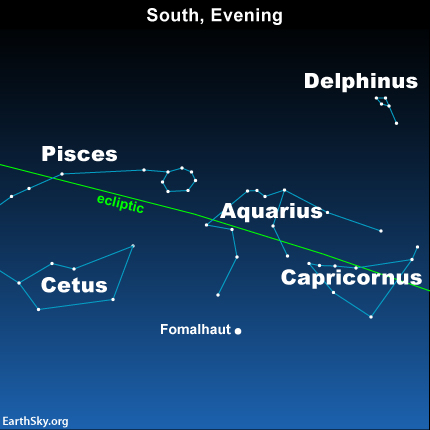
In most years, the bright star Fomalhaut is the only thing most people see in this part of the sky. You need a very dark sky to see the constellations of the celestial ocean.
No matter where you are on Earth, you need a very dark sky, a couple of hours after sunset, to see the constellations of the heavenly sea. This part of the sky – and these faint stars – are located southward in the evening now for Northern Hemisphere stargazers (overhead from the Southern Hemisphere). Many of the constellations in this part of the sky are connected with water, perhaps because the sun was moving in front of these stars on the great pathway of the ecliptic during a rainy season long ago. Astronomer Guy Ottewell has written of this region of the sky as being:
… watery in the sense that it is vague and dim, like a dark pool.
You’ll see these dim stars, if you’re looking in a dark-enough sky. Still, their constellations are identifiable, and no doubt the ancients knew them well. You can come to know them well, too.
Capricornus the Sea Goat. Capricornus represents a Sea Goat, but has the shape of an arrowhead on our sky’s dome. By late October and early November, in early evening, you’ll find this constellation past the meridian, or line drawn the sky’s dome from due north to due south. Read more about Capricornus.

Even at its highest, Capricornus stays close to the southern horizon as seen from mid-northern latitudes. Photo: Till Credner, AlltheSky.com.
Delphinus the Dolphin is a truly delightful little constellation that really resembles a dolphin leaping among the waves. Delphinus is one of the earliest constellations, first cataloged by the Greek astronomer Ptolemy in the second century. Sometimes, Delphinus is said to be the Dolphin that carried a Greek poet – Arion – safely away from his enemies. Other times, this sky Dolphin is said to represent the dolphin sent by the sea god Poseidon to find Amphitrite, the Nereid he wanted to marry. Read more about Delphinus and other small constellations.
Fomalhaut and Piscis Austrinus. In nearly every northern autumn, because the stars around it are so faint, the star Fomalhaut appears to shine in solitary splendor … but not this autumn, because of the bright planets also visible in this part of the sky. Still, Fomalhaut is easy to spot this year, too. In its large dark patch of sky, it alone shines brightly. Fomalhaut is sometimes called The Lonely One or The Solitary One. It’s said to be lonely because it’s noticeable as the only bright object in an otherwise “empty” region of the sky (no region of the sky is truly empty, of course). Fomalhaut is a blue-white star, located only a couple of dozen light-years away. Read more about Fomalhaut here.
Meanwhile, Piscis Austrinus is a small, round pattern of stars, supposedly the open mouth of the Southern Fish. But don’t expect to see a fish in these stars, but you can find Piscis Austrinus if your sky is dark. Look for it below a zig-zag line of stars stemming from Aquarius the Water Carrier. In skylore, the Water Carrier is supposed to be pouring water into the open mouth of Piscis Austrinus.
Aquarius the Water Carrier is usually portrayed as a man pouring a stream of water into the mouth of the Southern Fish (see above), which is interesting since fish don’t drink water. If your sky is dark enough, you can see a little asterism – or noticeable pattern of stars within Aquarius — just to the left of Aquarius’ star Sadal Melik. This little pattern, shown within the orange dashed oval in the star map below, is called the Water Jar in Aquarius. Imagine a cascade of faint stars as water, visible in very dark skies, making a zigzag stream of stars, flowing down toward the star Fomalhaut. Read more about Aquarius the Water Carrier.
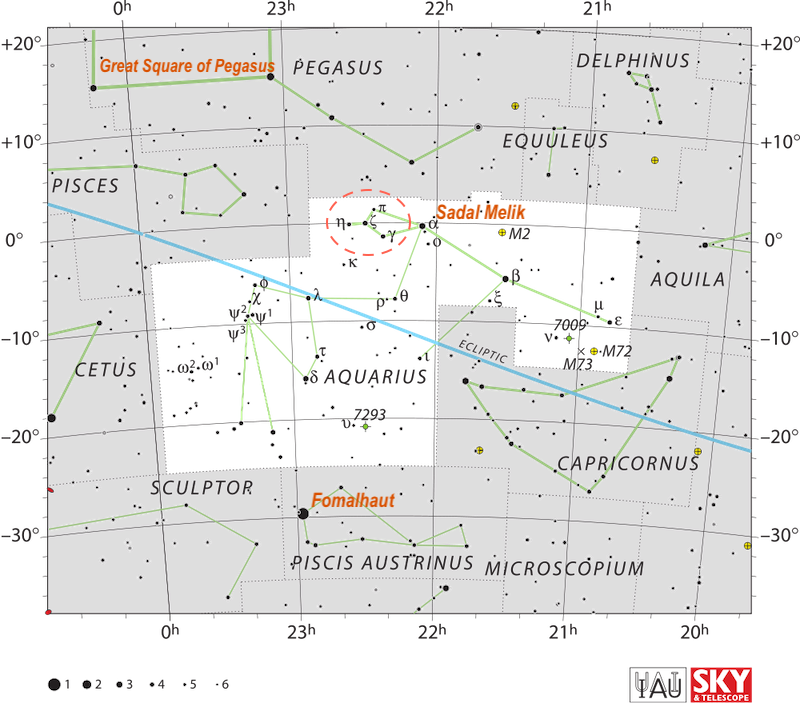
A map of the constellation Aquarius. The orange dashed oval region is the Water Jar asterism. See the zig-zagged line of stars under the Water Jar? In the night sky, you can imagine them as water pouring from the jar into the open mouth of Piscis Austrinus. Image via IAU/ Sky & Telescope/ Wikimedia Commons.
Pisces the Fishes. A Northern Hemisphere autumn (or Southern Hemisphere spring) – say, October or November – presents an opportune time for viewing Pisces in the evening sky. As seen from across the globe, Pisces reaches its high point for the night at about 10 p.m. local standard time in early November. Pisces the Fishes is sometimes called the first constellation of the zodiac because the sun appears in front of this constellation at the time of the March equinox. The constellation has the shape of a graceful V on our sky’s dome. Pisces’ alpha star Al Risha can be found where the two tails of the Fishes come together, at the point of the V. In late October 2020, you’ll also find the fiery red planet Mars in Pisces. Read more about Pisces the Fishes.

As seen from mid-northern latitudes, the constellation Pisces appears in the southeast as darkness falls in November. Photo: Till Credner, AlltheSky.com.
Cetus the Whale. Cetus is a somewhat unremarkable constellation. We call it a Whale, but it was a sea-monster in Greek mythology. It has one irresistible feature, though, its star Mira the Wonderful. Mira isn’t the brightest star in Cetus, but it’s the best known of the Whale’s stars, even though it can’t be seen much of the time. Mira varies in brightness, ranging from visibility as a rather faint star to total invisibility to the eye alone. Mira’s last brightness maximum was around late September or early October 2020, but the star might still be visible to the eye now, in a very dark sky. Read more about Mira and Cetus.
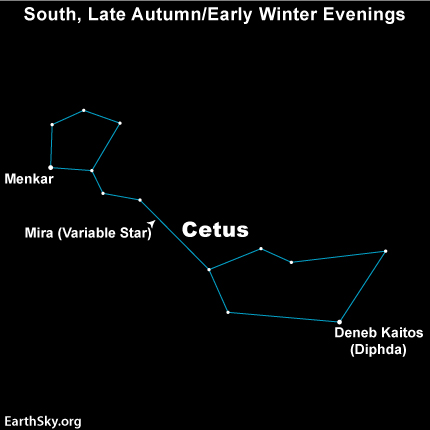
You can spot Mira’s constellation, Cetus, during the evening hours. Even at its brightest, Mira isn’t one of our sky’s brightest stars, but its regular variability makes it a super interesting star to come to know and to follow.
Eridanus the River. The great river of the sky, Eridanus, rises later at night than the other “watery” constellations in autumn, but, once it’s up, is large and easy to see in a dark-enough sky. That’s because the northern part of this constellation is located near the extremely prominent constellation Orion the Hunter. Eridanus appears to swell up in a great loop near Orion, then meander southward, finally – for most in the Northern Hemisphere – dropping out of sight below the southern horizon before it reaches its end. But if you are far enough south – below 33 degrees north latitude – you’ll spot the bright star Achernar, the End of the River. Read more about Achernar and Eridanus.
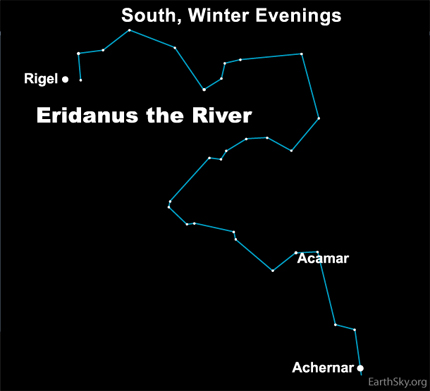
In a dark sky, you can see that Achernar marks the end of a great stream of stars known to the ancients as a celestial River. This is the constellation Eridanus the River, and Achernar is its brightest star.
Bottom line: The region of the sky around Fomalhaut is filled with what the ancients saw as “watery” constellations.
EarthSky’s guide to the bright planets
EarthSky astronomy kits are perfect for beginners. Order yours from the EarthSky store.
Source:
https://earthsky.org/constellations/the-constellations-of-the-celestial-ocean